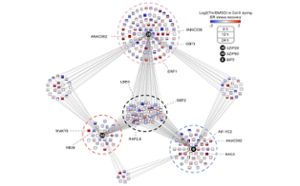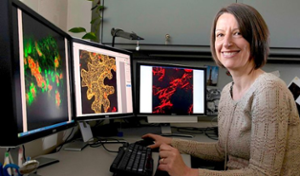Plant "ER": Advanced genomics illuminate new mechanisms for stress mitigation
As our planet’s climate continues to be unpredictable, understanding how plants respond to adverse environmental conditions becomes essential. Improving crop productivity will be vital to feed the nine billion people estimated to be alive in 2050.
When a plant is exposed to stressful conditions – such as drought, heat, cold stress and pathogen attack – the functionality of a key cellular organelle known as the endoplasmic reticulum (ER) is impeded, which can stunt the plant’s ability to grow and even lead to the death of the plant. This condition is known as ER stress, and researchers from plant biologist Federica Brandizzi’s lab in the MSU-DOE Plant Research Laboratory (PRL) are looking to understand how plants respond and adapt to it.

These researchers, including first author of the study and postdoc Dae Kwan Ko, investigated genes in the model plant Arabidopsis thaliana that, when activated, helped to mitigate ER stress. This study was recently published in Nature Plants.
The researchers developed a multi-omics pipeline for A. thaliana, in which different sets of genome-wide data were integrated for further analyses. Using this pipeline, they were able to identify a hormone-associated regulator that calibrates change in gene expression changes, which in turn helps to alleviate the effects of ER stress in the plant.
“People may think that DNA sequences outside of genes occur randomly, but they often have important functions that drive gene expression,” Ko said. “We computationally scanned DNA sequences in front of genes responsive to both ER stress and abscisic acid, which is an important plant hormone associated with many different biological processes including stress.”
The researchers identified a small DNA sequence called G-box as a key player in gene regulation.
“It was a quite surprise,” Ko continued, “because G-box has been known for modulating many significant biological processes, but its role in ER stress was unknown. This reflects how difficult it is to find a new regulator under ER stress.”

Genes often have multiple functions, and some of these functions are redundant within the plant. This can create challenges for identifying which genes do what. By analyzing the data from many angles, the researchers were able to identify the precise spot where they could pick out the correct gene that regulates ER stress response.
“Through a high-throughput protein-DNA interaction screen, we then discovered a plant hormone-associated regulator that physically bound the G-box to coordinate gene expression by competing with other existing regulators,” Ko said.
Protein-DNA interactions are a primary operation in gene regulation.
“With the DNA sequence and its interacting protein partner, Federica and I discussed their potential role countless times, established a hypothesis, delicately designed the studies and experimentally tested our idea,” Ko explained. “Such a hypothesis-driven research approach has enormous power in understanding science, and it’s really fun.”
This study provides new information on how genes respond to ER stress, as they precisely coordinate multiple regulators while they compete and collaborate.
“Biological molecules such as genes and proteins interact with each other all the time to accomplish their daily duties creating biological networks. It is similar to how our social networks function,” Ko said.

Such knowledge is vital to engineering plants with more tolerance to ER stress, which will thus have higher tolerance for adverse environmental conditions.
“Because the ER produces most of the plant proteins and lipids that we use for consumption in our daily diets, a better understanding of the mechanisms that control the activities of this organelle is of paramount importance for our species’ survival,” said Brandizzi, an MSU Foundation Professor and a pioneer in the implementation of advanced confocal microscopy for the study of plant organelles.
This research has implications in human medicine as well.
“Unresolved ER stress can cause many human diseases including diabetes and cancer,” Ko said. “Since most molecular components for ER stress response and the mechanisms are highly conserved, the new regulators and their function found in this study are likely conserved in other eukaryotic systems, indicating a broad applicability of our finding.”
This work was primarily supported by the National Institutes of Health (R35GM136637), with contributing support from the Great Lakes Bioenergy Research Center; U.S. Department of Energy, Office of Science, Office of Biological and Environmental Research (DE-SC0018409); the Department of Energy, Basic Energy Sciences Division (Grant: DE-FG02-91ER20021); and MSU AgBioResearch (MICL02598). This study was supported in part by MSU’s Institute for Cyber-Enabled Research Cloud Computing Fellowship.
Banner image: (L to R): Research technician Josh Deradoorian, undergraduate researcher Rita Barr and postdoctoral researcher Dae Kwan Ko in the Brandizzi lab. Credit: Kara Headley